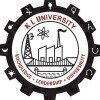Filter interviews by
Shree L R Tiwari College of Engineering Assistant Professor Interview Questions and Answers
7 Interview questions
The boundary conditions of my project are the limitations and constraints that define the scope of the project.
Boundary conditions are the external factors that affect the project
They define the limits of the project and what is within scope
Examples include budget, time, resources, and legal requirements
Boundary conditions must be considered when planning and executing the project
The 8 main pillars of engineering mechanics are statics, dynamics, mechanics of materials, fluid mechanics, thermodynamics, heat transfer, control theory, and biomechanics.
Statics deals with forces and their effects on stationary objects.
Dynamics deals with forces and their effects on moving objects.
Mechanics of materials deals with the behavior of solid objects subjected to stresses and strains.
Fluid mechanics de...
Machines are man-made devices that perform specific tasks, while structures are built to support loads and resist forces.
Machines are designed to perform a specific function, such as a car engine or a washing machine.
Structures are built to support loads and resist forces, such as bridges or buildings.
Machines are typically made up of moving parts, while structures are typically made up of stationary parts.
Machine...
h-method uses hierarchical basis functions while p-method uses polynomial basis functions in FEA.
h-method uses a fixed number of elements with varying degrees of freedom while p-method uses a fixed number of degrees of freedom with varying elements.
h-method is suitable for problems with singularities while p-method is suitable for problems with smooth solutions.
h-method is computationally efficient for problems wi...
Centrifugal pump works on the principle of converting mechanical energy into hydraulic energy.
The pump has an impeller that rotates and creates a centrifugal force to move the fluid.
The fluid enters the pump through the suction nozzle and is accelerated by the impeller.
The kinetic energy of the fluid is then converted into pressure energy as it passes through the volute casing.
The pressure energy is then used to m...
T-s diagram of reheating cycle
Reheating cycle is a modification of the Rankine cycle
It involves two turbines and one reheater
The T-s diagram consists of four processes: 1-2, 2-3, 3-4, and 4-1
The first turbine expands the steam from high pressure to intermediate pressure (process 1-2)
The steam is then reheated in the reheater at constant pressure (process 2-3)
The second turbine expands the steam from intermediate p...
Regenerative cycle uses heat exchangers to recover heat from exhaust gases while reheating cycle reheats steam between turbine stages.
Regenerative cycle improves efficiency by preheating the feedwater using exhaust gases.
Reheating cycle reduces moisture content in steam and increases efficiency.
Regenerative cycle is used in gas turbines while reheating cycle is used in steam turbines.
Both cycles aim to increase th...
Shree L R Tiwari College of Engineering Assistant Professor Interview Experiences
1 interview found
I applied via Newspaper Ad and was interviewed before Jan 2022. There were 2 interview rounds.

(8 Questions)
- Q1. Working principle of centrifugal pump
- Ans.
Centrifugal pump works on the principle of converting mechanical energy into hydraulic energy.
The pump has an impeller that rotates and creates a centrifugal force to move the fluid.
The fluid enters the pump through the suction nozzle and is accelerated by the impeller.
The kinetic energy of the fluid is then converted into pressure energy as it passes through the volute casing.
The pressure energy is then used to move t...
- Q2. Difference between machine and structure
- Ans.
Machines are man-made devices that perform specific tasks, while structures are built to support loads and resist forces.
Machines are designed to perform a specific function, such as a car engine or a washing machine.
Structures are built to support loads and resist forces, such as bridges or buildings.
Machines are typically made up of moving parts, while structures are typically made up of stationary parts.
Machines req...
- Q3. Draw T-s digram of reheating cycle
- Ans.
T-s diagram of reheating cycle
Reheating cycle is a modification of the Rankine cycle
It involves two turbines and one reheater
The T-s diagram consists of four processes: 1-2, 2-3, 3-4, and 4-1
The first turbine expands the steam from high pressure to intermediate pressure (process 1-2)
The steam is then reheated in the reheater at constant pressure (process 2-3)
The second turbine expands the steam from intermediate pressu...
- Q4. Regenerative cycle vs reheating cycle
- Ans.
Regenerative cycle uses heat exchangers to recover heat from exhaust gases while reheating cycle reheats steam between turbine stages.
Regenerative cycle improves efficiency by preheating the feedwater using exhaust gases.
Reheating cycle reduces moisture content in steam and increases efficiency.
Regenerative cycle is used in gas turbines while reheating cycle is used in steam turbines.
Both cycles aim to increase the eff...
- Q5. Difference between h and p method in fea
- Ans.
h-method uses hierarchical basis functions while p-method uses polynomial basis functions in FEA.
h-method uses a fixed number of elements with varying degrees of freedom while p-method uses a fixed number of degrees of freedom with varying elements.
h-method is suitable for problems with singularities while p-method is suitable for problems with smooth solutions.
h-method is computationally efficient for problems with lo...
- Q6. Difference between fea and fem
- Ans.
FEA and FEM are both numerical methods used for solving engineering problems, but FEA is a subset of FEM.
FEA stands for Finite Element Analysis, while FEM stands for Finite Element Method.
FEM is a broader term that encompasses FEA as well as other numerical methods.
FEA is used to analyze the behavior of a structure or component under various loads and conditions.
FEM is used in a variety of fields, including structural ...
- Q7. What are boundary conditions of your project
- Ans.
The boundary conditions of my project are the limitations and constraints that define the scope of the project.
Boundary conditions are the external factors that affect the project
They define the limits of the project and what is within scope
Examples include budget, time, resources, and legal requirements
Boundary conditions must be considered when planning and executing the project
- Q8. What are the 8 main piller of engineering mechanics
- Ans.
The 8 main pillars of engineering mechanics are statics, dynamics, mechanics of materials, fluid mechanics, thermodynamics, heat transfer, control theory, and biomechanics.
Statics deals with forces and their effects on stationary objects.
Dynamics deals with forces and their effects on moving objects.
Mechanics of materials deals with the behavior of solid objects subjected to stresses and strains.
Fluid mechanics deals w...
Interview Preparation Tips
- Engineering mechanics
- Engineering
- Engineering Drawing
- Python
- FEA
- Kom
- Som
Top trending discussions






Interview questions from similar companies

Assistant Professor Interview Questions & Answers
Suresh Gyan Vihar Universityposted on 4 Oct 2017
Interview Questionnaire
3 Questions
- Q1. Introduction
- Q2. Subject knowledge
- Q3. Discuss case study

Assistant Professor Interview Questions & Answers
Galgotias Universityposted on 27 Dec 2021
I applied via Facultyplus and was interviewed before Dec 2020. There was 1 interview round.
Interview Questionnaire
1 Question
- Q1. Basic accountancy questions were asked. Questions regarding PhD status were also asked.
Interview Preparation Tips

I applied via Naukri.com and was interviewed in Jun 2020. There were 3 interview rounds.
Interview Questionnaire
1 Question
- Q1. Mainly from my research work, article and LLM specialization
Interview Preparation Tips

I appeared for an interview before Aug 2020.
Interview Questionnaire
1 Question
- Q1. 1. DBMS basics 2. Algorithms and Data structures
Interview Preparation Tips

I applied via Company Website and was interviewed in Aug 2021. There were 2 interview rounds.

Interview Preparation Tips

(2 Questions)
- Q1. Subjective and Good Experience
- Q2. Technical and Good Experience.
(2 Questions)
- Q1. Current job and experience.
- Ans.
Currently working as a Research Assistant at XYZ University with 3 years of experience in conducting experiments and analyzing data.
Research Assistant at XYZ University
3 years of experience in conducting experiments and analyzing data
- Q2. Salary expectations.
Interview Preparation Tips

(2 Questions)
- Q1. The pannel contain 3 members all are friendly, Q1 introduce yourself Q2intrested subject Ans:i choose c and data structure and DBMS Q3 they asked me to explain about array and pointers Q4 diff between st...
- Q2. This was my first round
Interview Preparation Tips


(2 Questions)
- Q1. Question about research and subject questions
- Q2. Research and revenue generation
Interview Preparation Tips
Please don't trust them . I wasted my precious time because of them and suffered a lot.

I applied via Naukri.com and was interviewed in Apr 2022. There was 1 interview round.
(1 Question)
- Q1. Questions were based on your research ppt.
Interview Preparation Tips
Shree L R Tiwari College of Engineering Interview FAQs
Tell us how to improve this page.
Interview Questions for Popular Designations
- Lecturer Interview Questions
- Associate Professor Interview Questions
- Professor Interview Questions
- Assistant Lecturer Interview Questions
- Assistant Professor 1 Interview Questions
- Assistant Professor 2 Interview Questions
- Visiting Faculty Interview Questions
- Assistant Professor 3 Interview Questions
- Show more
Overall Interview Experience Rating
based on 1 interview experience
Difficulty level
Duration
Assistant Professor Interview Questions from Similar Companies

Shree L R Tiwari College of Engineering Assistant Professor Reviews and Ratings
based on 4 reviews
Rating in categories
|
Assistant Professor
12
salaries
| ₹3 L/yr - ₹6 L/yr |
|
Lecturer
3
salaries
| ₹1.4 L/yr - ₹3 L/yr |
|
Manual Software Test Engineer
3
salaries
| ₹6 L/yr - ₹12 L/yr |

GD Goenka Public School

Pearson Education India

Mahendra’s Institute

Global Indian International School
- Home >
- Interviews >
- Shree L R Tiwari College of Engineering Interview Questions












